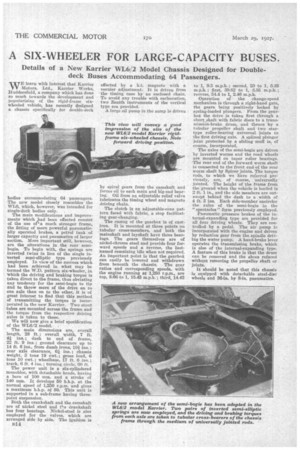A SIX-WHEELER FOR LARGE-CAPACITY BUSES.
Page 84

If you've noticed an error in this article please click here to report it so we can fix it.
Details of a New Karrier WL6/2 Model Chassis Designed for Doubledeck Buses Accommodating 64 Passengers.
WE learn with interest that Karrier -Motors, Ltd., Karrier Works, Huddersfield, a company which has done so much towards the •development and popularizing of the rigid-frame sixwheeled vehicle, has recently designed a chassis specifically for double-deck
bodies accommodating 64 passengers. The new model closely resembles the WI,6, which, however, was intended for single-deck bodies only.
The main modifications and improvements which _had been effected consist of the use of' a much stronger frame, the fitting of more powerful pneumatically operated brakes, a petrol tank of larger capacity and pneumatics of larger section, More important still, however, are the alterations in the roar semibogie. To begin with, the springs are inverted twins in lieu of the single inverted semi-elliptic type previously employed. In view of the success which had been achieved in what may be termed the W.D. pattern six-wheeler, in 'which the driving and braking torque is taken direct to the frame, thus obviating any tendency for the semi-bogie to tip and to throw more of the drive on to one axle than on to the other, it is of great interest to find that this method of transmitting the torque is incorporated in the new Karrier. Two stout tubes are mounted across the frame and the torque from the respective driving axles is taken to these.
We will now give a brief specification of the WL6/2 model.
The main dimensions are, overall length, 28 ft. ; overall width, 7 ft. 44 ins.; dash to end of frame, 22 ft. 9 ins.; ground clearance up to 14 ft. 6 ins., from dumb irons, 10i ins. ; rear axle clearance, ei ins.; chassis weight, 3 tons 19 cwt.; gross load, 6 tons 10 cwt.; wheelbase, 17 ft. 6 ins. ; track, 6 ft. 4 ins.; turning circle, 60 ft.
The power unit is a six-cylindered monobloc, with detachable heads, having a bore of 100 min. and a stroke of 140 mm. It develops 50 b.h.p. at the normal speed of 1,250 r.p.m. and gives a maximum b.h.p. of 80. This unit is supported in a sub-frame having threepoint suspension.
Both the crankshaft and the camshaft are of nickel steel and tlie crankshaft has four bearings. Nickel-steel is also employed for the valves, which are arranged side by side. The ignition is
D14
effected by a h.t. magneto with a vernier adjustment. It is driven from the timing case by an enclosed chain. To avoid any trouble with carburation, two Zenith instruments of the vertical type are provided.
A large oil pump in the sump is driven by spiral gears from the camshaft and forces oil to each main and big-end bearing. Oil from an adjustable relief valve lubricates the timing wheel and magneto driving chain.
The clutch is an adjustable-cone pattern faced with fabric, a stop facilitating gear-changing.
The casing of the gearbox is of castiron. It is mounted at three points on tubular cross-members, and both the mainshaft and layshaft have three bearings. The gears themselves are of nickel-chrome steel and provide four forward speeds and a reverse, the lastnamed remaining idle when not required. An important point is that the gearboi can easily be lowered and withdrawn from beneath the chassis. The gear ratios and corresponding speeds, with the engine running at 1,250 r.p.m., are top, 8.66 to 1, 15.45 m.p.h.; third, 14.42
to 1, 9.3 m.p.h. ; second, 25 to 1, 5.35 m.p.h. ; first, 39.82 to 1, 3.35 m.p.h. ; reverse, 54.4 to 1, 2.48 m.p.h.
Operation of the change-speed mechanism is through a right-hand gate, the gears being positively locked by spring-loaded plungers. From the gearbox the drive is taken first through a short_shaft with fabric discs to a transmission-brake drum, and thence by a tubular propeller shaft and two startype roller-bearing universal joints to the first driving axle. A splined plunger joint protected by a sliding muff is, of course, incorporated.
The axles of the semi-bogie are driven by inverted worms and the road wheels are mounted on taper roller bearings. The rear end of the forward worm shaft is connected to the front end of the rear worm shaft by Spicer joints. The torque• rods, to which we have referred previously, are, of course, universally jointed. The height of the frame from the ground when the vehicle is loaded is 2 ft. 1 in., and the side members are outswept behind the dash to a width of 4 ft. 3 ins. Each side-member encircles the axles of the semi-bogie in the "spectacles" form previously employed.
Pneumatic pressure brakes of the internal-expanding type are provided for all four driving wheels. They are controlled by a pedal. The air pump is incorporated with the engine and driven by reduction gear from the spindle driving the water pump. A hand-brake lever operates the transmission brake, which is also of the internal-expanding type. A feature of this brake is that the drum can be removed and the shoes refaced without removing the propeller shaft or joints.
It should be noted that this chassis Is equipped with detachable steel-disc wheels and 36-in. by 8-in. pneumatics.












































































































































































